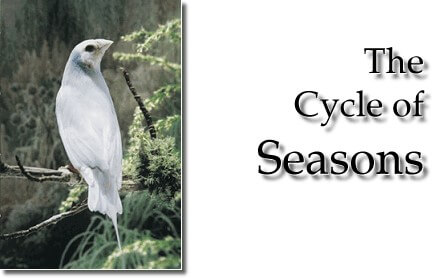 The seasonal feeding of gouldians, benefits and why
The seasonal feeding of gouldians, benefits and why
Articles and Information - Lady Gouldian Finch
Before one can fully understand the importance of our bird's diet, I believe that it is important to understand the cycle of seasons that our birds should experience throughout each year. This yearly cycle would include the Resting, Breeding and the Molting Seasons. An additional cycle might be the Juvenile phase because it has its own special needs, especially when it comes to diet.
These cyclical changes in birds are influenced by three factors of the Lighting they receive, the Temperature they experience and the Diet they eat. Some species of bird are influenced by one of these requirements more than another. For example, some birds, like the Lady Gouldian Finch, are not triggered to breed based upon day length, while their annual molt is triggered by day length and temperature. These birds are more susceptible to the quality and quantity of the food available to trigger the breeding response. Other birds, like the Canary, are triggered to breed in response to the day length, whereas they will automatically molt once breeding season ends. This is why it is important, above and beyond the information in this article, to know everything you can about the species that you are keeping as caged birds.
So many times I have been asked, "When should my birds breed?" The answer to that question can be difficult to answer if your birds experience a constant temperature, constant lighting and the same food, day after day after day. Their seasonal cycles are totally intertwined, so even if they do decide to breed and lay eggs, often times the eggs are infertile, abandoned, or the babies that hatch are pitched out of the nest.
If we consider the seasons that wild birds cycle through each year, we realize that nothing about their lives is static and consistently the same. The length of their daylight hours change as the seasons progress one to another, as does the amount and quality of their food when the rains come or the cold weather advances. Wild birds raise their young when food is plentiful and of good quality. Otherwise all the effort that goes into this endeavor would produce weak offspring or no future generations at all.
Length of Days
Lighting is an important factor in replicating the length of days in the wild for our captive birds. The seasons experienced by a "wild" bird are much easier to duplicate when your birds are housed outdoors, but most captive birds are housed inside with us, and are not exposed to the changing seasons in nature. If they are kept in a room where we spend a big part of our evening downtime, they might have lighting until 10 or 11 PM each night. Likewise, if we have to feed them before we leave for work each morning, they may be awakened as early as 5 or 6 AM. These can be very long days for our birds, who need rest to remain healthy and active. These long days over an extended period of time can cause our birds to become temporarily infertile which can present problems if you are wanting your birds to breed and raise babies.
 Placing your cage near a window or door for nature's daylight cycles
Placing your cage near a window or door for nature's daylight cycles
Mother Nature's Cycle
The best way to house and light your birds would be near a window, or at least in a room where they can see daylight everyday. They will not have the benefit of UV light like they would outdoors, as UV cannot penetrate glass, but they will be more able to adjust their 24 hour cycles based upon Mother Nature. If there is no additional lighting provided to their cage/flight, they will awaken with the dawn, and go to sleep at dusk. This is natural and very important. If you will be spending additional time in this room in the evening, but particularly during the winter (shorter daylight) months, I highly recommend covering the cage after the sun has gone down. Noise isn't a factor here as much as having the length of days fluctuating constantly. Of course I wouldn't recommend having a party in the room while birds are resting, but normal evening activities should not present a problem.
If your birds are in a room where outside daylight can be seen, and if you do have additional lighting supplied to your birds by either fluorescent or incandescent bulbs, the lights should be on timers. I personally use UV lighting on all my flights and large cages. The UV bulbs will not supply enough UV intensity for the birds to synthesize vitamin D3 through the skin around their eyes and on their legs. However, this isn't as much of a problem for our pet birds because the supplements available today have added D3.
The reason that I use the UV bulbs is because experiments have shown that there are UV reflectance properties in the feathers of some birds, notably the Lady Gouldian Finch. It is logical to assume that this plays some role in mate selection for birds with these feather characteristics. It has also been shown that lack of proper UV lighting can result in agitation, feather picking, muscular weakness, breeding problems and metabolic disorders.
The timers should be adjusted to coincide with the daylight hours in your time zone so that they come on slightly after daybreak and go off shortly before dusk. Thus your birds will experience a natural waking and settling down time each day. You want to prevent your birds from being abruptly awakened each morning or suddenly plunged into total darkness each evening. Specific setting times cannot be given for everyone as the times will vary depending upon where in your time zone your city location is positioned. Basically they should coincide with the increasing advancement of daylight (in the Northern Hemisphere) after December 21st and the decreasing day lengths after June 21st each year. This would be just the opposite in the Southern Hemisphere. I realize that this morning wake up may not be possible when the birds must be fed before you leave the house. A gradual lighting intensity may be necessary with several lamps to allow a natural wake up.
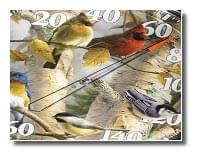 timers should be adjusted to coincide with the daylight hours in your time zone
timers should be adjusted to coincide with the daylight hours in your time zone
The daylight cycle of short Winter days and long Summer days with Fall's decreasing day length and Spring's increasing day length adjusted accordingly, is probably the most important part of your birds' lives next to their diet. It is one of the things that we can have control over when our birds live indoors with us.
Temperature Control
Because we want our homes warmed and cooled for our own comfort, temperature control probably will not be as easy to duplicate as that experienced by their wild counterparts. Every species of bird has its own reaction to temperature events, usually based upon the area of the world in which they live. Some wild birds molt as the days are lengthening and warming in the spring. Others molt after their yearly breeding period. They all breed when food is plentiful, usually in the Spring, Summer or Fall. Some species are considered to be opportunistic breeders and will breed year round when conditions are right. Almost all birds rest during the winter months when the temperatures are cool and food isn't as plentiful. Most species of birds that we keep as pets come from regions of the world where their winter temperatures are not extremely cold, but rather cool compared to the summer heat. Therefore, we are not talking about changing their climate in our homes an extreme amount, perhaps from 80 degrees F to 70 degrees F. It is important for you to know and understand how the species of bird you live with reacts to the temperatures and food supply in the wild. This is doubly important if you are trying to house and breed different species under the same conditions in your home.
With an effort towards energy conservation these days, perhaps your homes are cooler in winter and slightly warmer in the summer. This would be ideal for your birds. Always remember that your birds will be stressed if the temperatures fluctuate too much from day to day. A gradual cooling in winter and warming in summer would be best, with the temperatures remaining fairly constant throughout each day. I do believe that if birds can gradually adjust to cooler temperatures throughout the winter, they will be hardier overall. But in our homes, these cooler temps may never be very practical for our own comfort. If your birds have their own "bird room" where the temps will not affect the rest of the home, acclimation to the cooler winter temperatures could be a life saver if your electricity goes out and they are unable to be maintained at their usual temperatures. Many species of birds can be acclimated to outdoor environments and temperatures. However it should be noted that breeding should be stopped if they don't naturally do it voluntarily, as hens are especially vulnerable to egg-binding during colder weather.
Since temperature controls for our birds will most likely be based upon our comfort, this is probably the one seasonal cycle that will be slightly out of kilter in comparison to their "wild" cousins. But if the other two can be duplicated as closely as possible, the birds will not suffer any harmful side effects.
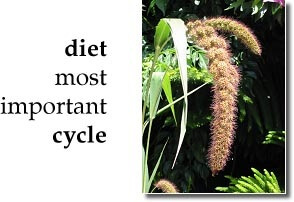 Diet is the most important cycle - ladygouldianfinch.com
Diet is the most important cycle - ladygouldianfinch.com
Diet and Exercise
Diet is the most important factor that you should take into consideration when caring for your birds, especially if your desire is to have them successfully breed and raise babies. This is true whether you are keeping finches, cockatiels or the large hook-billed parrots. The diet should coincide with the other two seasonal cycles and be appropriate to the exercise level that you can make available to your birds. High calorie and high energy diets during the resting season will not only upset the yearly cycle, but could result in obese birds when they do not have extra energy requirements placed on them for molting, breeding and raising babies. If they are lucky enough to have a large flight cage to live in (10' long x 4' deep x 7' high,) they will have plenty of exercise all year long and obesity should not become an issue. But if they live in a small cage (30" long x 18" deep x 18" high,) their health and ability to breed could be compromised by lack of exercise. You must be extra careful not to allow their diet to become too carbohydrate heavy when they do not have the ability to burn it off through exercise.
Strive to Duplicate Nature
Extra protein and energy foods added to the diet as breeding season is coming on will induce the breeding response in our caged birds, as it duplicates the increase in the quality and quantity of foods available to wild birds. As an example, in Northern Australia, when the summer rains end and the cooling temperatures of autumn induce the dormant seeds in fields and grasslands to sprout, the wild Gouldians in Australia are finishing up their yearly molt and the juveniles are completing their first juvenile molt. In several months there will be many seeding grass-heads to supply the additional protein needed for the newly hatched and rapidly growing chicks of the new breeding season. The insects also begin to multiply during the spring rains allowing those species that are insect eaters to raise their young. This is what we are striving to duplicate in order to inspire our caged birds to choose mates, build nests and produce a new crop of healthy chicks that will not be abandoned or pitched.
Don't get me wrong. I am not saying that all Gouldian babies will never be pitched again if we follow nature as closely as possible. I believe that there are other factors involved in "pitched" babies. Gouldians are not the only species to pitch and kill their offspring. I have had the proverbial "best parents in the bird world", Society and Zebra finches, pitch their own babies. Age, diet and security play a big part in this behavior. What I do believe, however, is that when we get our caged birds ready for the breeding season by building up to it through a proper resting and molting season and then patiently wait until the birds have come into breeding condition, they are much more likely to raise their own babies successfully. When their natural seasonal cycles are consistently followed, they will be as ready as possible to be healthy, good, dependable parents.
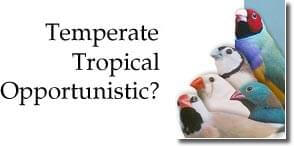 Temperate, Tropcial, Opportunistic?
Temperate, Tropcial, Opportunistic?
In order for you to get the seasonal cycle correct for the species of bird that you are raising, you will have to investigate the requirements for that species of bird. There are three distinct breeding patterns among the finches we keep as caged birds: temperate, tropical and opportunistic.
Finches classified as temperate-type, breed during the Spring/Summer. They depend upon day-length intervals to trigger a breeding response. They live in areas where winter rainfall patterns and warmer temperatures bring about an early flush of seeds in Spring through early Summer. Once the heat of Summer starts and day lengths reach 14 hours they naturally stop breeding and begin their molt. Most Canaries are classified as temperate-type breeders.
Those finches classified as tropical-type breed during Autumn and early Winter until temperatures become too cold. They depend upon the Summer rainfall to stimulate their breeding response. The green seeding grass-heads will ripen at about the time their first clutch of chicks are ready to be fed. The Lady Gouldian Finch, Blue-faced Parrot Finches, Masked Grassfinches and Green Singing Finches fall into this category. Day lengths vary very little from season to season in their part of the world so this is not an issue for tropical-type finches. Extended day light hours in the aviary are not necessary. In the wild, they are not out looking for seed to feed the chicks at 10:00PM. Tropical-type finches naturally molt in Spring or very early Summer as the wet season approaches and temperatures are rising. The past season's youngsters will be going through their first juvenile molt at this same time.
Opportunistic breeding finches live in very, dry, almost desert regions of the world where the opportunity for seasonal breeding and molting is severely limited. These finches have an almost continuous molt throughout the year which allows them to take advantage of breeding whenever there is a food supply suddenly available, such as following a drought breaking rain. Zebra Finches and Bengalese Finches fall into this category. In captivity, since these finches sleep in their nest at night, their nesting boxes/baskets and a good food supply are always available to them, so they will breed all the time. But it is not healthy to allow them to breed year round in captivity. Summer would be the best time to stop opportunistic breeding and allow them a complete, natural molt.
You will have the best breeding success if you house birds with similar breeding patterns together. Remember to pay attention to the seasons that are referred to in books written by authors from different hemispheres as regards to molting, breeding and resting, not to the months of the year. The seasons and corresponding months are almost an exact opposite from the northern to southern hemispheres. There will be slight variations depending upon how far north or south you live in the hemisphere. That is why the seasons (moisture, warmth and coldness) are more important than the months.
Importance of Molting
It is very important that all finches have this non-breeding time once each year to replace all their feathers. This time is called the molt. If necessary, you will need to remove all nestboxes and reduce the high-energy foods to stop breeding and allow them to have a natural molt cycle. Birds allowed to breed during what would be their natural molting cycle could have hormonally induced feathering problems and quite often experience balding. This will not happen in birds that are bred at the correct time of year and are allowed to molt at the appropriate time.
The diet is very important during both of these (breeding and molting) nutrient demanding times. Reducing the high-energy foods should naturally stop breeding, but this does not mean that an austerity diet should be implemented. Quality nutrition is essential for a successful molt. My hope is that you are beginning to see how day length, temperature and diet are intertwined completely to allow as natural an existence for our caged birds as can be possible. Captivity can never be as good as freedom, but with our help, the caged birds that we live with should be happy, healthy and strong.
Austerity Diet?
Have you ever read or heard an experienced bird breeder talk about the "austerity diet" that they supply to their birds during the resting period? I'll bet they didn't explain exactly what they meant by "austerity diet". This is unfortunate because this austerity period is vital to a successful breeding that will follow. If your flock has gained weight during the previous year due to lack of activity or from feeding high calorie foods when there was no demand for such foods, the austerity diet is a must.
For the Gouldian finches living in Northern Australia, there is a period of time near the end of the dry season when seed supplies are scarce. Depending upon the amount of rainfall and its duration in the previous wet season, there may be a plentiful supply of seed for raising chicks with enough left over to carry the birds thru their annual molt until the next wet season brings forth a fresh supply of seed for the next breeding season.
Most years, the seed supply dwindles. The seeds that are left are not the preferable Sorghum seed that the Gouldian relishes, forcing them to migrate to areas containing seeding perennial grasses to tide them over until the Sorghum again sets seed after the wet season rains begin.
In order to duplicate this austerity period, you will need to remove everything but seed and fresh water from your bird's diet. This means no supplementation, no cuttlebone or other calcium supplements, no greens or veggies just plain seed and water, plus plenty of exercise in a large flight cage. I have to admit that the first time I did a complete austerity diet for 5 weeks, I was a nervous wreck the entire time. I was convinced that removing the supplementation from my birds was going to kill them.
But far from killing your birds, this time period will slim them down, removing any extra weight they may have acquired during the previous year. It will also flush out any excess supplementation that they have been getting. But most of all, it will cause all of their sexual organs to shrink in response to the limited diet. This allows all the birds to start their upcoming breeding season from the same point ground zero. For when the austerity period ends, you will gradually begin to provide them with an increase in the quality and quantity of food that will trigger their breeding response, bringing all those healthy, vital birds into breeding condition at the exact same time.
Once the Gouldian hens' beak have darkened, you will be able to put your pairs together again and provide them a nest box. Within days, you should see eggs being laid by compatible pairs and within weeks hear chicks begging!
It is extremely important that you are certain that your flock really needs an Austerity Cycle by carefully holding and examining them for excess weight gain.
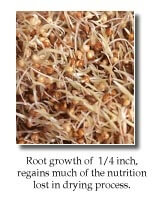 Sprouting the best thing you can do for your birds!
Sprouting the best thing you can do for your birds!
© lady gouldian finch.com 2017